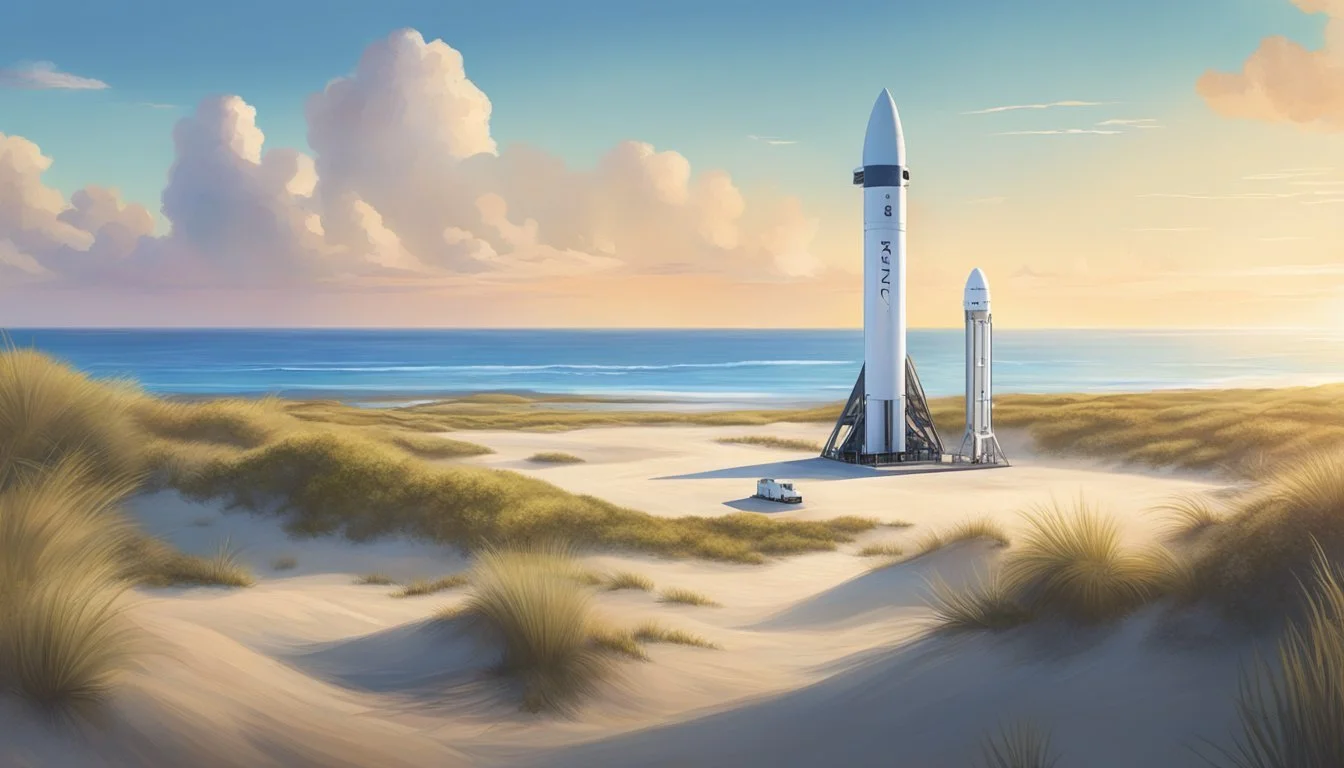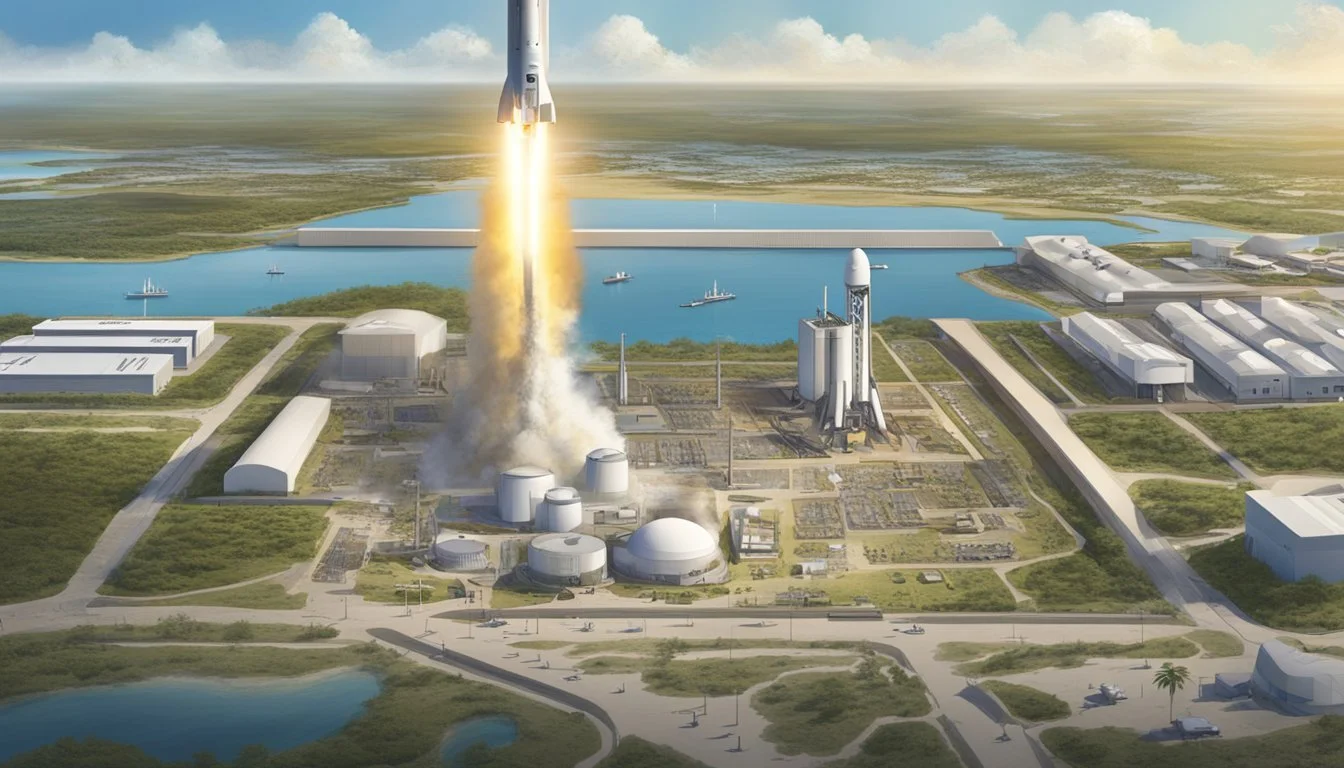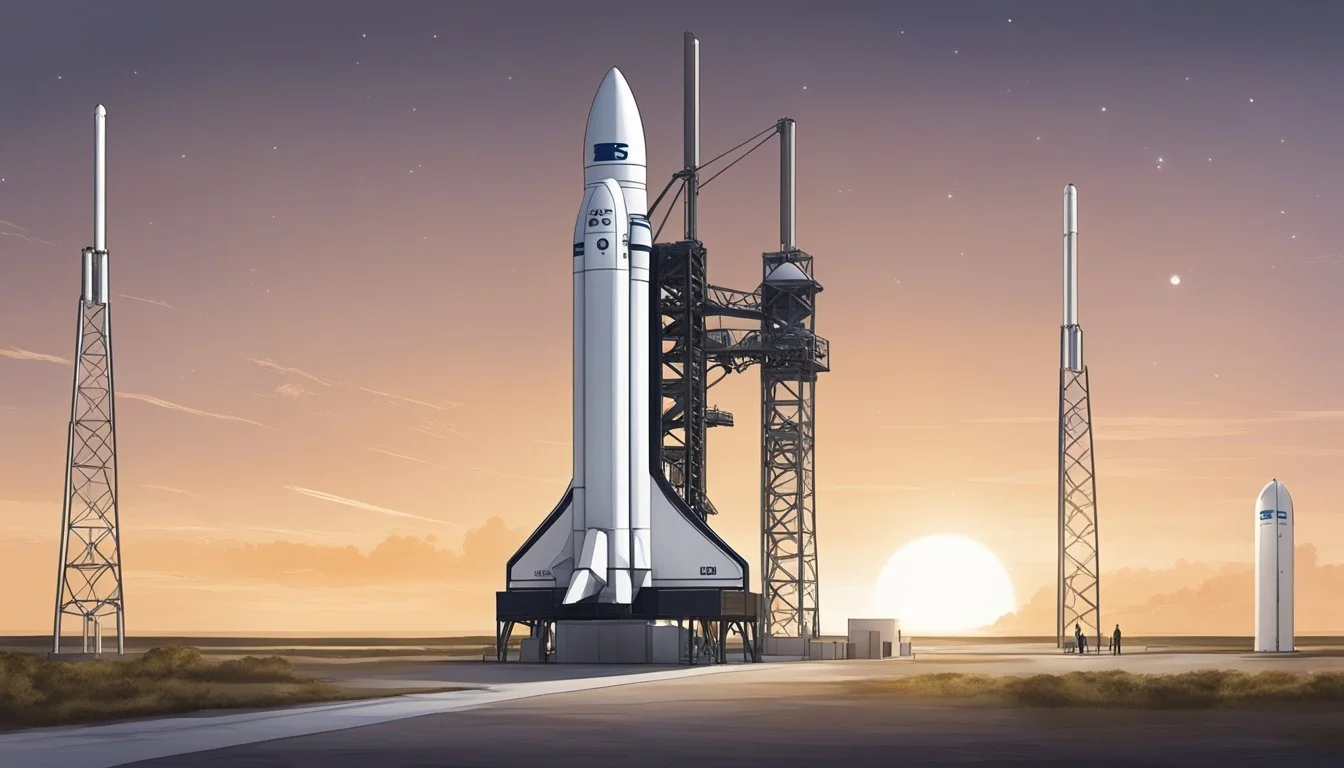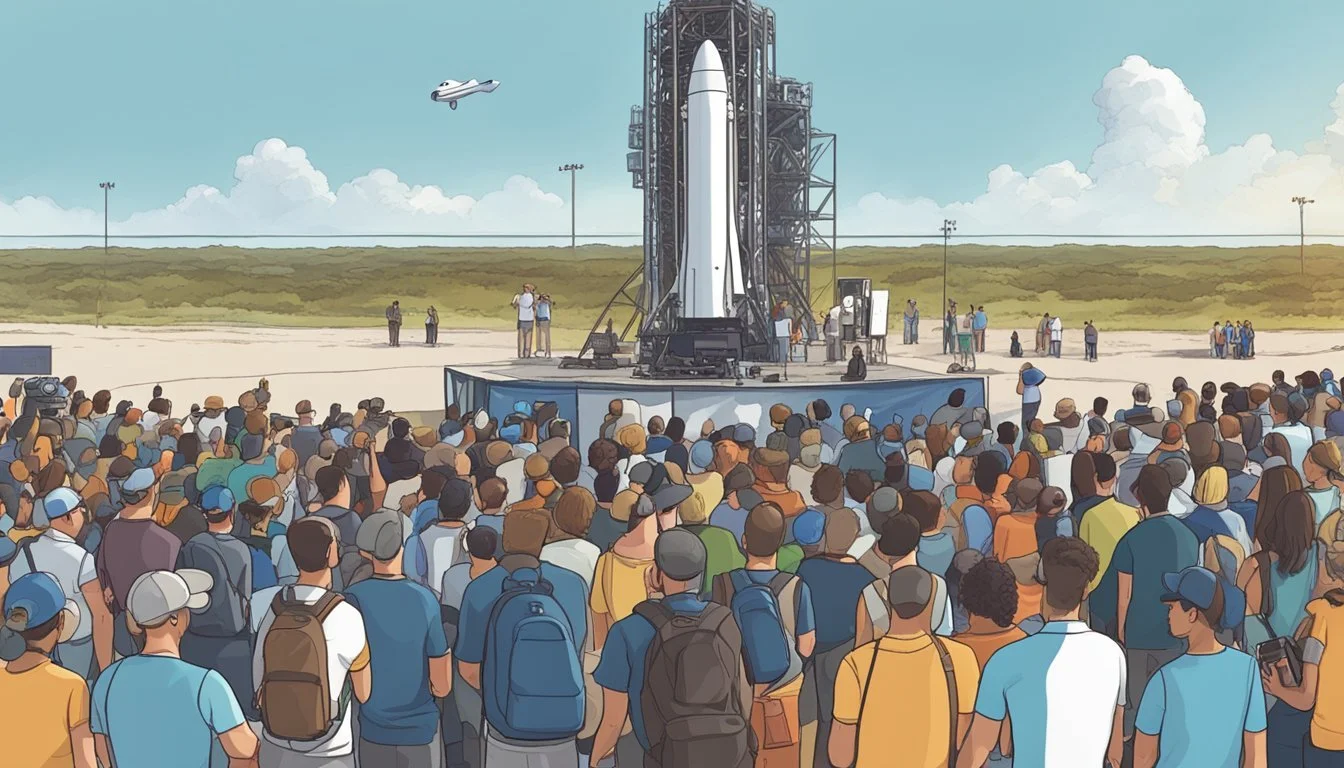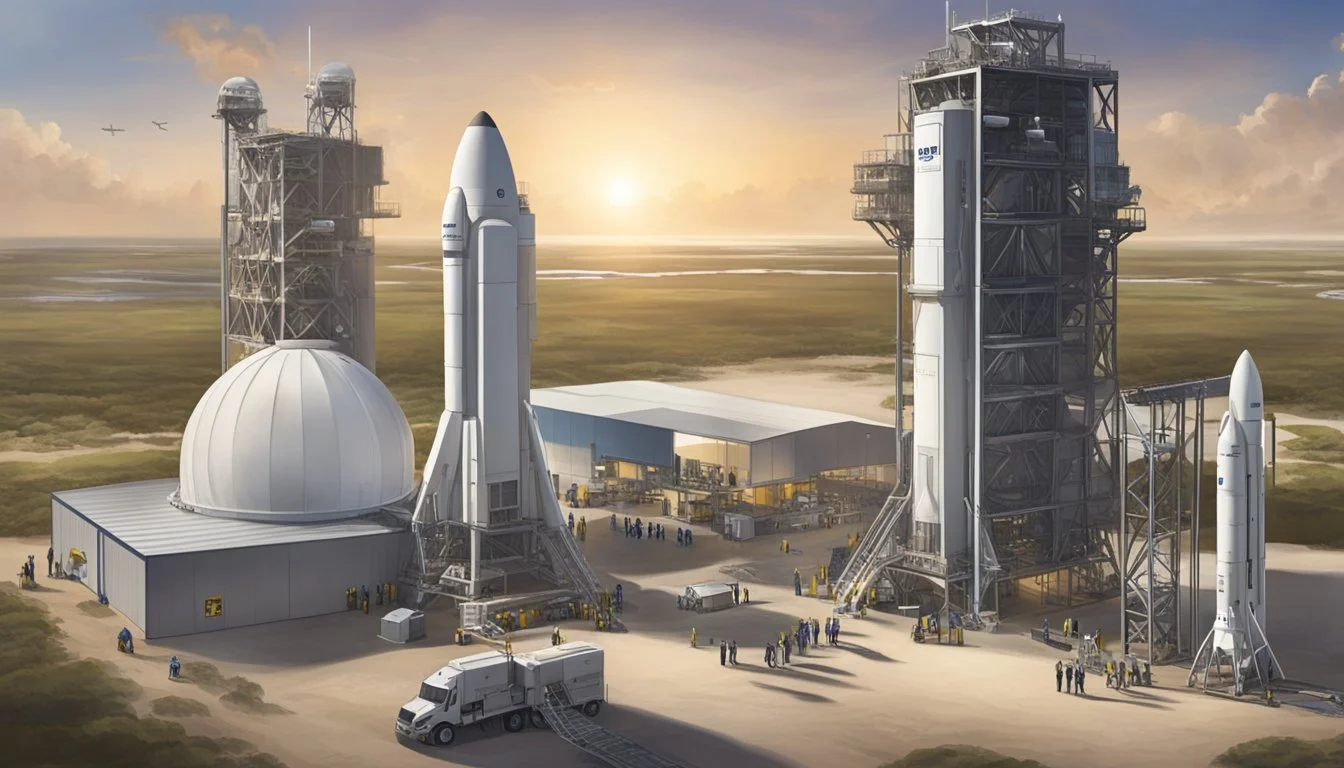SpaceX Boca Chica Launch Site: The Thrilling Heart of Next-Gen Space Travel!
SpaceX's Boca Chica Launch Site, also known as Starbase, stands as a testament to the company's ambitious space exploration goals. Located near Brownsville, Texas, this sprawling complex serves as the primary testing and production facility for SpaceX's Starship launch vehicles. The site has rapidly evolved from a remote beach area to a bustling hub of aerospace innovation, showcasing SpaceX's commitment to pushing the boundaries of space technology.
The Boca Chica facility encompasses three main areas: the production site, the launch site, and the structural test site. Each plays a crucial role in the development and testing of Starship prototypes. The launch site, visible from State Highway 4, features a prominent launch tower and has already hosted significant test flights, including the first fully stacked Starship launch in April 2023.
As SpaceX continues to advance its Starship program, the Boca Chica Launch Site remains a focal point for space enthusiasts and local residents alike. The facility's presence has transformed the surrounding area, bringing both economic opportunities and environmental considerations to the forefront of discussions about the future of commercial spaceflight in Texas.
History of SpaceX Boca Chica
SpaceX's Boca Chica facility has undergone significant development since its inception. The site has transformed from an empty stretch of Texas coastline into a bustling spaceport and manufacturing complex.
Initial Development and Construction
SpaceX broke ground at Boca Chica on September 22, 2014. Elon Musk promised substantial investments in South Texas at the time. The company began constructing launch facilities, integration towers, and support buildings.
Initial progress was slow due to environmental concerns and local regulations. SpaceX had to navigate complex permitting processes and address wildlife protection issues.
By 2016, the first tracking antenna was installed. Road improvements and utility infrastructure upgrades followed. SpaceX also acquired additional land around the original site to expand its footprint.
Transition to Starbase
In 2019, SpaceX shifted focus at Boca Chica from Falcon rocket operations to Starship development. This change marked the site's evolution into "Starbase."
The company ramped up construction of production facilities and test stands. New structures appeared rapidly, including tank farms, launch mounts, and the iconic "high bay" assembly building.
SpaceX began producing Starship prototypes on-site. The first "Starhopper" test vehicle flew in 2019, reaching 150 meters altitude.
Boca Chica village residents faced increasing pressure to sell their properties as SpaceX expanded. Many homeowners eventually agreed to buyouts.
Major Milestones
Starbase has hosted numerous high-altitude Starship test flights since 2020. These tests provided valuable data for vehicle development.
Key achievements include:
SN8: First high-altitude flight and controlled descent (December 2020)
SN15: First successful landing after high-altitude flight (May 2021)
Orbital launch tower completion (2021)
Ship 24 and Booster 7 full-stack fit checks (2022)
SpaceX continues to upgrade Starbase infrastructure for orbital Starship launches. The site now features two launch pads, multiple test stands, and extensive production facilities.
Environmental reviews and regulatory approvals remain ongoing challenges as SpaceX aims for orbital flights from Boca Chica.
SpaceX Launch Vehicles
SpaceX has developed a range of powerful and innovative launch vehicles to support its space exploration and satellite deployment missions. These include the reliable Falcon rockets and the ambitious Starship system currently under development.
The Falcon Fleet
The Falcon 9 is SpaceX's workhorse rocket, capable of delivering payloads to orbit and beyond. It features a reusable first stage that can land vertically after launch. The Falcon Heavy, essentially three Falcon 9 first stages strapped together, is currently the world's most powerful operational rocket.
Falcon 9 specifications:
Height: 70 meters
Diameter: 3.7 meters
Payload to Low Earth Orbit: 22,800 kg
The Falcon Heavy can lift over 63,500 kg to Low Earth Orbit, making it ideal for heavy satellite launches and interplanetary missions. Both vehicles have demonstrated high reliability and cost-effectiveness through their partially reusable design.
The Starship and Super Heavy
Starship is SpaceX's next-generation fully reusable launch system. It consists of two main components: the Starship spacecraft and the Super Heavy booster. This system is designed for a wide range of missions, from orbital satellite deployment to deep space exploration.
Key features of Starship:
Fully reusable
Stainless steel construction
Raptor engines using methane fuel
Super Heavy, the first stage booster, will be the largest and most powerful rocket stage ever built. It is designed to lift Starship out of Earth's atmosphere before separating and returning for a vertical landing.
Comparisons to Other Launch Vehicles
SpaceX's launch vehicles offer significant advantages in terms of payload capacity and cost-effectiveness compared to many competitors. The Falcon 9's reusability has drastically reduced launch costs, while the Falcon Heavy outperforms many heavy-lift rockets in its class.
Payload comparison to Low Earth Orbit:
Falcon 9: 22,800 kg
Atlas V 551: 18,850 kg
Ariane 5 ECA: 21,000 kg
The Starship system, once operational, is expected to surpass all current launch vehicles in terms of payload capacity and reusability. Its potential for rapid reuse and in-orbit refueling could revolutionize space travel and enable ambitious missions to Mars and beyond.
Launch Site Infrastructure
SpaceX's Boca Chica launch site features advanced facilities to support Starship operations. Key components include the orbital launch pad, propellant storage systems, and multiple launch mounts for testing and orbital flights.
Orbital Launch Pad
The orbital launch pad at Boca Chica is designed to withstand the extreme forces of Starship launches. It incorporates a massive steel launch tower standing approximately 146 meters tall. This structure houses the "chopstick" arms used for stacking and catching Starship vehicles.
The pad features a water deluge system to suppress acoustic energy and protect the infrastructure during liftoff. Cryogenic lines run throughout to supply super-chilled propellants to the vehicle.
A flame diverter underneath the pad redirects exhaust gases away from the launch mount. This critical component helps protect both the pad and the surrounding area from the intense heat and pressure of Starship's 33 Raptor engines at full thrust.
Propellant Tank Farm
The propellant tank farm stores and supplies the large quantities of fuel needed for Starship launches. It consists of multiple spherical and cylindrical tanks for liquid methane and liquid oxygen.
Key features:
Cryogenic storage capabilities
High-volume transfer systems
Redundant safety mechanisms
The farm can rapidly load over 3,000 tons of propellant for a fully-fueled Starship and Super Heavy booster stack. Insulated pipelines connect the tanks to the orbital launch mount for efficient fueling operations.
Orbital Launch Mount B
Orbital Launch Mount B serves as an alternative launch platform at Boca Chica. It provides SpaceX with additional testing and launch capabilities for the Starship program.
The mount incorporates:
Robust steel construction
Propellant quick-disconnect systems
Holddown clamps for the vehicle
Like the primary orbital pad, Mount B features its own water deluge and flame deflector systems. This redundancy allows SpaceX to conduct parallel operations or switch launch sites as needed for increased flexibility in the Starship development and launch schedule.
Regulatory Compliance and Public Engagement
SpaceX's Boca Chica launch site has undergone extensive regulatory scrutiny and community engagement. The Federal Aviation Administration (FAA) has played a central role in overseeing the project's environmental and safety aspects.
FAA Oversight and Environmental Assessment
The FAA conducted a comprehensive environmental review of SpaceX's proposed Starship/Super Heavy launch operations at Boca Chica. This process included a Draft Tiered Environmental Assessment to evaluate potential impacts on the surrounding area.
The agency required SpaceX to implement over 75 mitigation measures to address environmental concerns. These actions aim to minimize the project's effect on wildlife, air quality, and local communities.
SpaceX had to obtain experimental permits and vehicle operator licenses from the FAA's Office of Commercial Space Transportation. This ensures compliance with safety regulations and environmental standards.
Public Meetings and Comment Periods
The FAA hosted public meetings to gather input from local residents and stakeholders. These events provided a platform for community members to voice their opinions and concerns about the Boca Chica launch site.
The agency also opened multiple public comment periods. This allowed citizens, organizations, and government entities to submit written feedback on the project's potential impacts.
SpaceX and the FAA worked to address issues raised during these engagement efforts. They considered public input in refining mitigation strategies and operational plans.
Record of Decision
Following the environmental review and public engagement process, the FAA issued a Record of Decision. This document outlines the agency's final determination on SpaceX's Boca Chica operations.
The Record of Decision specifies required mitigation measures and operational constraints. It serves as a legally binding agreement between SpaceX and the FAA.
This decision allows SpaceX to proceed with Starship/Super Heavy launches, subject to ongoing compliance with environmental and safety requirements. The FAA continues to monitor operations and may require additional measures if needed.
Environmental Considerations
SpaceX's Boca Chica launch site operations have significant environmental implications. The company has implemented measures to mitigate impacts while working with regulatory agencies and conservation groups.
Environmental Impact of Launch Activities
The FAA conducted environmental assessments of SpaceX's Starship/Super Heavy launch program at Boca Chica. Potential impacts include noise pollution, air quality effects, and debris from failed launches.
SpaceX has installed sound monitoring equipment and uses water deluge systems to reduce noise and heat during launches. The company also conducts debris cleanup operations after test flights.
Air quality concerns relate to emissions from rocket fuel combustion. SpaceX uses cleaner-burning methane fuel to minimize pollutants compared to other propellants.
Laguna Atascosa and Wildlife Conservation
The nearby Laguna Atascosa National Wildlife Refuge hosts endangered species like the piping plover. SpaceX coordinates with U.S. Fish and Wildlife Service to minimize disturbances.
Launch schedules avoid peak nesting and migration periods. The company funds habitat restoration projects and wildlife monitoring programs in the area.
SpaceX has also implemented lighting restrictions to reduce impacts on sea turtle nesting. Beach closures during launches help protect sensitive coastal habitats.
Collaborations with Environmental Organizations
SpaceX partners with conservation groups to enhance environmental stewardship. The company works with the Center for Biological Diversity on wildlife protection initiatives.
Joint efforts focus on habitat preservation, species monitoring, and public education. SpaceX provides funding for research on launch impacts to local ecosystems.
The company also collaborates with state agencies to ensure compliance with the Clean Water Act and other environmental regulations. Regular water quality testing monitors potential contamination from launch activities.
Community and Economics
SpaceX's Boca Chica launch site has significantly impacted the surrounding area. The facility has brought economic opportunities, infrastructure improvements, and increased attention to the region, while also raising concerns about environmental and community effects.
Brownsville and Cameron County
Brownsville, the largest city in Cameron County, has experienced notable changes since SpaceX's arrival. The launch site's proximity has put this Texas border town on the map for space enthusiasts and tourists. Local officials have embraced the company's presence, viewing it as a catalyst for economic development and technological innovation.
Cameron County has seen increased tax revenues and property values due to SpaceX's operations. The company's expansion has also led to land acquisitions and buyouts of some local residents, sparking debates about the balance between progress and preserving the area's character.
Local Economy and Employment
SpaceX has created hundreds of jobs in the region, ranging from engineering positions to support staff roles. This influx of employment opportunities has attracted skilled workers to the area, boosting the local talent pool.
The company's presence has stimulated growth in related industries:
Aerospace suppliers
Hospitality and tourism
Construction and real estate
Local businesses, particularly in Brownsville and South Padre Island, have reported increased customer traffic due to SpaceX employees and space enthusiasts visiting the area.
Infrastructure and Amenities
SpaceX's development has led to improvements in local infrastructure. Highway 4, the main road to the launch site, has been upgraded to accommodate increased traffic and transportation needs.
New amenities have emerged to cater to the growing population and visitor influx:
Hotels and vacation rentals
Restaurants and retail establishments
Educational programs focused on STEM fields
While these changes benefit many residents and visitors, some locals have expressed concerns about rising costs of living and alterations to the area's traditionally quiet, coastal character.
Launch Operations and Mission Profiles
SpaceX's Boca Chica launch site conducts diverse operations, from suborbital tests to orbital flights. The facility supports Starship and Super Heavy vehicle launches, with capabilities for payload deployments and landings.
Pre-Launch Procedures
SpaceX begins each mission with meticulous pre-launch checks. Engineers conduct tank tests and static fire engine tests to verify system integrity. The launch team monitors weather conditions and ensures range safety compliance.
Fueling operations commence hours before liftoff, with liquid oxygen and methane loaded into Starship and Super Heavy. The launch pad is cleared of personnel, and final system checks are performed remotely.
Mission control verifies all systems are go before initiating the launch countdown. In the final minutes, Starship switches to internal power and the launch director gives the final approval to proceed.
Orbital Launches and Landings
Orbital launches from Boca Chica involve the full Starship and Super Heavy stack. The Super Heavy booster ignites its Raptor engines, lifting the vehicle off the pad. After stage separation, Starship continues to orbit while Super Heavy attempts a controlled landing.
Starship can remain in orbit for extended periods, performing maneuvers and payload deployments. For return, it reenters the atmosphere and executes a vertical landing at designated sites.
SpaceX aims to achieve rapid reusability, with both stages capable of multiple flights. This approach significantly reduces costs and turnaround times between missions.
Payload and Satellite Deployments
Starship's large payload capacity enables diverse mission profiles. It can deploy multiple satellites in a single launch, supporting constellation buildouts for communications and Earth observation.
The vehicle is designed to dock with the International Space Station, potentially delivering cargo and crew. Its spacious cargo bay can accommodate large scientific instruments or components for space infrastructure.
For interplanetary missions, Starship can carry supplies and equipment for lunar or Martian expeditions. Its ability to land on other celestial bodies opens new possibilities for space exploration and colonization efforts.
Public Interaction and Media
SpaceX's Boca Chica launch site has become a focal point for public engagement and media coverage. The facility attracts space enthusiasts and casual observers alike, while also maintaining a strong online presence.
Tourism and Viewing Opportunities
SpaceX's Boca Chica site draws numerous visitors eager to witness rocket launches firsthand. Isla Blanca Park on South Padre Island serves as a popular viewing spot, offering clear sightlines to the launch pad across the water.
The park often fills with spectators during test flights and launches. Local businesses have adapted to cater to the influx of space tourists, offering launch-viewing packages and themed merchandise.
SpaceX occasionally hosts public events at the site, allowing closer access to the facilities. These events give attendees a rare glimpse into the inner workings of a cutting-edge spaceport.
Live Streaming and Online Presence
SpaceX maintains a robust online presence, particularly for Boca Chica activities. The company regularly live streams launches and major tests from the site, drawing millions of viewers worldwide.
These streams offer real-time commentary and multiple camera angles, providing an immersive experience for those unable to attend in person. SpaceX's social media accounts keep followers updated on launch schedules and milestones.
Independent streamers and space enthusiasts also contribute to the site's online visibility. They often set up cameras near the facility, offering 24/7 views of rocket assembly and launch preparations.
This constant online coverage has turned Boca Chica into a virtual space tourism destination, accessible to anyone with an internet connection.
Future Outlook and Expansion Plans
SpaceX's Boca Chica launch site is poised for significant growth and development in the coming years. The company has ambitious plans to expand its facilities, enhance launch capabilities, and push the boundaries of space exploration.
Next-Generation Vehicles
SpaceX continues to focus on Starship development at Boca Chica. The company aims to achieve rapid reusability and increase payload capacity for future missions. Starship prototypes undergo regular testing and refinement at the site.
Engineers are working to improve heat shield technology and propulsion systems. SpaceX plans to conduct more high-altitude tests and orbital launches from Boca Chica in the near future.
The company is also developing infrastructure to support Starship operations, including expanded launch pads and propellant storage facilities.
Long-Term Goals for Space Exploration
Boca Chica plays a crucial role in SpaceX's vision for interplanetary travel. The company aims to establish a sustainable presence on Mars using Starship as the primary transportation system.
SpaceX is designing Starship to support long-duration missions and carry large crews. The vehicle will be capable of transporting cargo and passengers to the Moon, Mars, and potentially beyond.
The Boca Chica site serves as a testing ground for technologies needed for deep space exploration, including life support systems and in-situ resource utilization.
Partnerships and Collaborative Efforts
SpaceX is actively seeking partnerships to advance its space exploration goals. The company collaborates with NASA on various projects, including potential Starship missions to the Moon under the Artemis program.
Commercial partnerships are also expanding, with SpaceX offering launch services to satellite operators and other space companies from Boca Chica.
The company is working closely with regulatory agencies to ensure compliance with environmental and safety standards as it expands operations at the site.
SpaceX continues to engage with the local community, participating in clean-up initiatives and discussing plans for future development in the area.
Technical Aspects of SpaceX Operations
SpaceX's Boca Chica launch site incorporates cutting-edge technology and innovative approaches to spaceflight operations. The facility supports extensive rocket engine testing, pioneering launch site innovations, and operates under an experimental permit framework.
Rocket Engine Testing
SpaceX conducts rigorous testing of its Raptor engines at the Boca Chica site. These engines, designed for the Starship and Super Heavy vehicles, undergo static fire tests to verify performance and reliability. The testing area features specialized flame deflectors and sound suppression systems to manage the intense heat and noise generated during engine firings.
Engineers analyze data from each test to refine engine designs and optimize performance. The site's proximity to production facilities allows for rapid iteration and improvements based on test results.
Launch Site Innovations
Boca Chica's launch infrastructure includes several innovative elements. The launch mount incorporates a water deluge system to reduce acoustic energy and protect the pad during liftoffs. A massive "chopstick" catch system on the launch tower aims to recover returning vehicles.
SpaceX has implemented autonomous flight termination systems for enhanced safety. The company also utilizes cryogenic storage facilities for propellants and a network of ground cameras and sensors for real-time monitoring during operations.
Experimental Permit
SpaceX operates the Boca Chica site under an experimental permit from the FAA. This permit allows for research and development activities, including test flights of prototype vehicles. The permit specifies operational constraints and safety requirements.
Key aspects of the experimental permit include:
Limitations on flight altitude and range
Mandatory risk assessments for each operation
Requirements for public notifications before launches
Protocols for coordinating with local authorities and airspace users
The permit process ensures SpaceX maintains high safety standards while advancing its development goals.
SpaceX Launch History at Boca Chica
SpaceX's Boca Chica launch site has been the focal point of Starship development and testing since 2019. The facility, located near Brownsville, Texas, has hosted numerous test flights and launches of Starship prototypes.
The first major flight test at Boca Chica occurred on August 27, 2019, when the Starhopper vehicle completed a 150-meter hop. This marked the beginning of SpaceX's ambitious Starship testing program at the site.
Throughout 2020 and 2021, SpaceX conducted several high-altitude tests of Starship prototypes. These flights aimed to demonstrate the vehicle's ability to perform controlled descents and landings.
Notable launches include:
SN8: First high-altitude flight (December 9, 2020)
SN15: First successful landing (May 5, 2021)
Starship Flight 7: Latest FAA-approved mission (as of January 2025)
Each test flight provided valuable data for SpaceX engineers, allowing them to refine the Starship design and launch procedures. The Boca Chica site has played a crucial role in advancing SpaceX's goal of developing a fully reusable spacecraft for missions to the Moon, Mars, and beyond.
As of early 2025, SpaceX continues to use the Boca Chica facility for Starship testing and development. The site remains a key location for the company's ambitious space exploration plans.


